History of the study of the moon with automatic vehicles - part 1
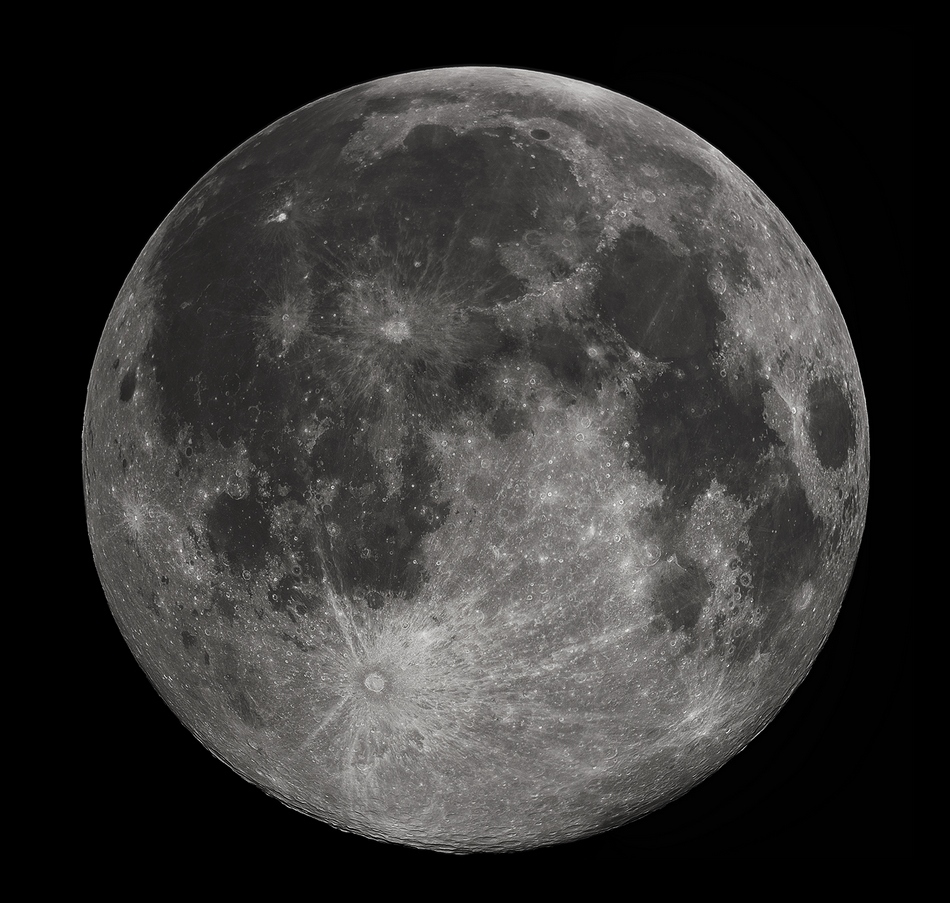
From the launch of the first satellite of the Earth to the beginning of the exploration of the Moon by spacecraft, a period of less than one and a half years passed. And there is nothing surprising in this since the Moon is the closest object to the Earth and a very unusual object for the Solar System: the Earth / Moon mass ratio exceeds all other satellites of the planets and is 81/1 - the closest such indicator is only 4226/1 for Saturn /Titanium.
Due to the fact that volcanic activity on the moon quickly faded away (due to its relatively low mass) its surface is very ancient and is estimated at almost 4.5 billion years old, and the absence of the atmosphere leads to the accumulation on the surface of meteorites reach and even exceed the age of the solar system itself. All this, in addition to the proximity of the Moon to us, caused an active scientific interest among people and a desire to explore it: the total number of spacecraft sent for its study (including failed missions) already exceeds 90 pieces. And it is about all their diversity and will be discussed today.
The first steps
The first explorations of the Moon began rather poorly both in the USSR and in the USA: even the fourth successful were only the fourth of the series of vehicles launched to the Moon (Luna-1 and Pioneer-3, respectively). This was not surprising since the exploration of the moon started at the moment when both they and we had a couple of successful satellite launches so very little was known about the conditions of outer space. By adding to this limited technical difficulties, spacecraft could not be stuffed with heaps of sensors at that time, as it can be done now (so that one could only guess at times about the causes of the accident) - and one can imagine the conditions at which spacecraft designers sometimes had to work.
Discussion of the failure of the station "Luna-8" from the book "Korolev: Facts and Myths" by Ya. K. Golovanov , a journalist who almost became an astronaut:
“You see, what's the matter, comrades ...” began Sergei Pavlovich with the voice of a kind storyteller, in which crafty notes slipped. - Chertok will now give you a long and muddy explanation of how it was and why it didn't work out. But all this is not important. Therefore, I do not even want him to unfold his posters. Understand the main thing: there is a process of knowledge. Yes, we are mistaken, we do stupid things, sometimes serious failures happen. Understand, we are now broke into the area, unknown to us, unknown to anyone. But from start to start, we are getting closer to success. I believe in him. We are so close to victory that I can guarantee: the next attempt will be successful. The process of learning is underway, - Korolev repeated once more, made a short pause and added: - And it seems to me that there is no need for all of us to waste time and listen to Chertok ...The first spacecraft that was able to conduct direct exploration of the moon and gain a second space velocity was the Luna-1 station launched on January 2, 1959. Outwardly, she strongly resembled Sputnik-1:

Earth's first artificial satellite (left), and Luna-1 station (right)
The same spherical shape, the same four antennas ... but in fact between these two satellites had little in common: Satellite-1 had only a radio transmitter while on the Moon-1 several scientific instruments had already been installed. With the help of them, it was first established that the Moon does not have a magnetic field and the solar wind was first recorded. Also during its flight, an experiment was conducted to create an artificial comet: at a distance of about 120 thousand km from the Earth, a cloud of sodium vapor was released from the station, weighing about 1 kg, which was recorded as an object of the 6th magnitude .

The Luna-1 station assembled with the “E” block - the third stage of the Vostok-L launch vehicle, with the help of which the Luna-2 and Luna-3 stations were also launched.
A film dedicated to the station Luna-1
Initially, the Moon-1 was supposed to be broken on its surface, but during the preparation of the flight, the delay from the MCC to the vehicle was not taken into account (at that time radio command control was applied from the ground) and the engines that worked a little later than the required number of kilometers missed. Well, “rocket science” was never a simple matter ...
On March 3, 1959, an American Pioneer-4 vehicle was sent along the same flight path with a set of second cosmic velocity. His goal was to study the moon from the flight path, but a miss as much as 60 thousand km led to the fact that the photoelectric sensor could not fix the moon and photographing it failed, but the Geiger counter found that the lunar neighborhood does not differ in radiation level from the interplanetary medium.
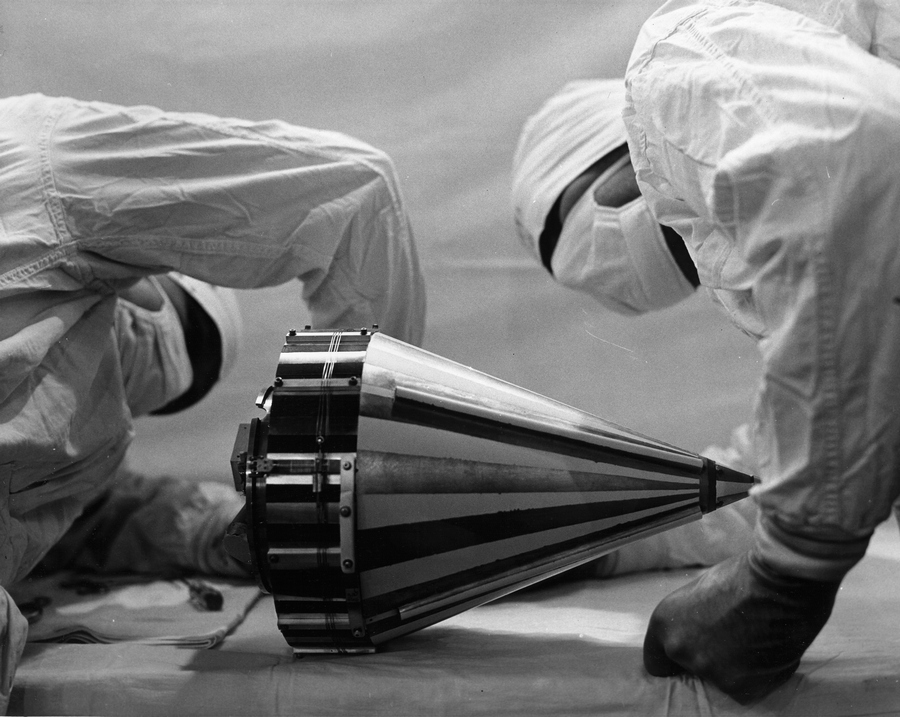
Assembly of the Pioneer-3 vehicle - a complete analog of the Pioneer-4
September 12, 1959 was launched Luna-2 station. For her, besides getting into the moon, an additional task was set - to deliver the pennant of the USSR to the Moon. By that time, the systems of orientation and correction of the orbit were not yet ready, so the blow was supposed to be serious - at a speed of more than 3 km / s. The developers of the device went into two technical tricks: 1) the pennants were placed on the surface of two balls with a diameter of about 10 and 15 cm:
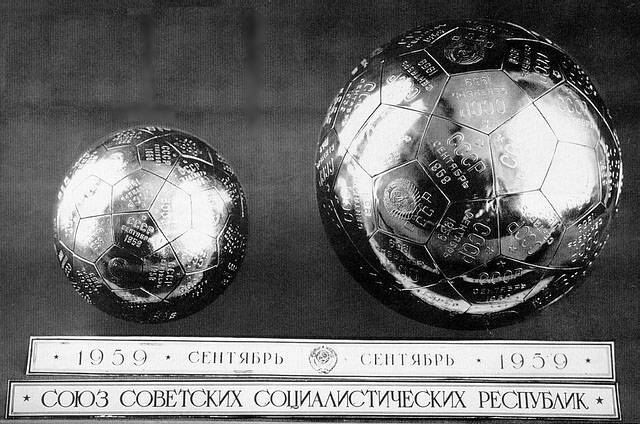
When the Moon “touched” the explosive charge inside these balls detonated, which allowed some of the pennants to extinguish the speed relative to the Moon.
2) Another solution involved the use of aluminum tape 25 cm long on which the inscriptions were made. The tape itself was placed in a robust housing filled with a liquid with a density similar to that of a tape, and this housing in turn was placed in a less durable one. At the moment of impact, the outer case crumpled and extinguished the impact energy. The liquid served as an additional shock absorber and allowed to be confident in the safety of the tape. All this construction was located at the third stage of the rocket which put the station on the trajectory of departure to the Moon. The fact that the station and the last stage hit the Moon was recorded, but nothing is known about how well the pennants were well preserved. Perhaps in the future, an expedition of space scientists will be able to answer this question.
By October 7, 1959, the first images of the back side of the Moon were obtained using the Luna-3 station, which started on October 4, like all the other missions of the Luna program from Baikonur. It weighed 287 kilograms and it already had a full-fledged system of orientation on the Sun and the Moon providing accuracy of 0.5 degrees when shooting. The station first used the gravity maneuver:

The trajectory of the flight of the station Luna-3 - this trajectory was calculated under the leadership of Keldysh in order to ensure the station's flight over the territory of the USSR when it returns to Earth. The next gravitational maneuver will be performed only by Mariner 10, flying near Venus on February 5, 1974.
Interesting was the method with which the shooting was carried out: first, the pictures were taken with the help of photographic equipment, then the film appeared and digitized with the help of a camera of a running beam, after which it was transmitted to Earth. To avoid the risk of the device’s failure before returning to Earth (the flight to the Moon and back took more than a week), two communication modes were provided: slow (when the device was at the Moon, far from the receiving station) and fast (for communication when the device flew over the USSR). The decision to duplicate the communication system turned out to be absolutely correct - the station was able to transmit only 17 of the 29 pictures taken by it, after which the connection with it was interrupted and it was no longer possible to restore it.

The world's first photograph of the far side of the moon. The photo was of mediocre quality due to interference with signal transmission. But the following photos were already much better:
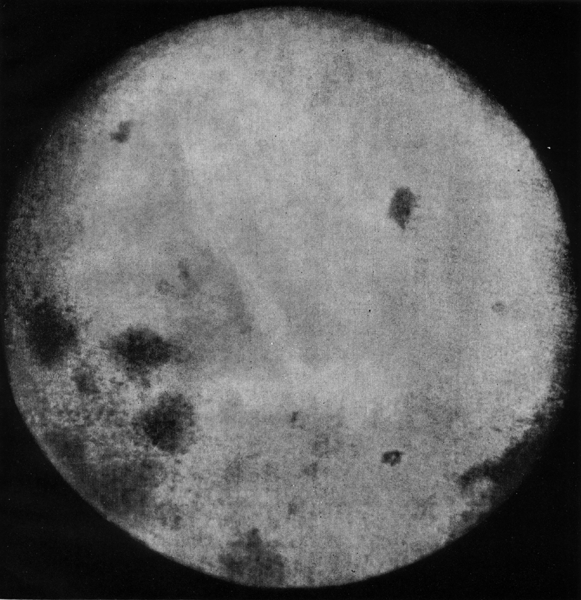
As a result, using these 17 images, we managed to build a rather detailed map:
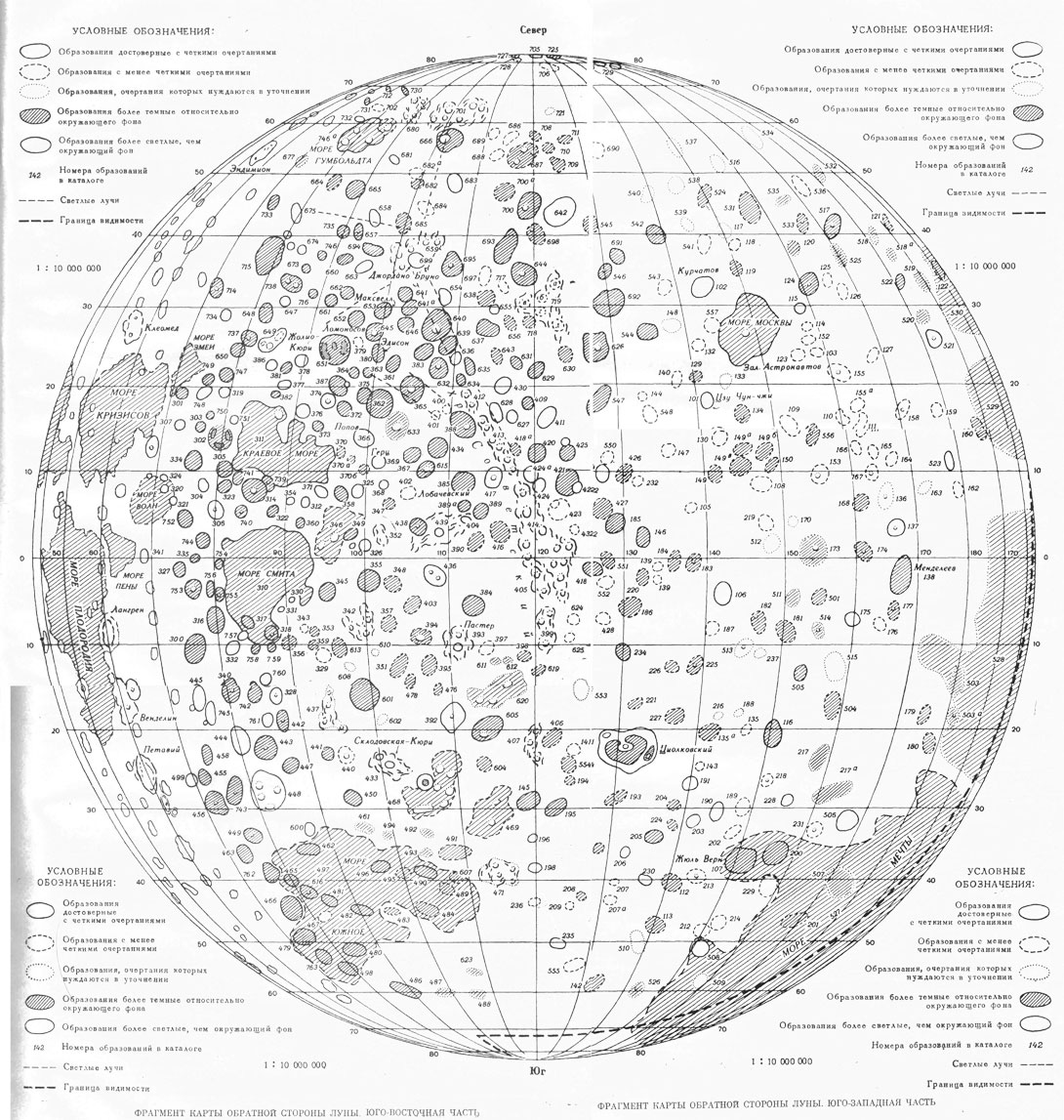
Photos of the visible side of the moon in high resolution were taken by Ranger 7 launched on July 28, 1964. Since this was the only purpose of this device, as many as 6 television cameras were installed on board, which in the last 17 minutes of flight before the collision had transferred 4300 images of the Moon .
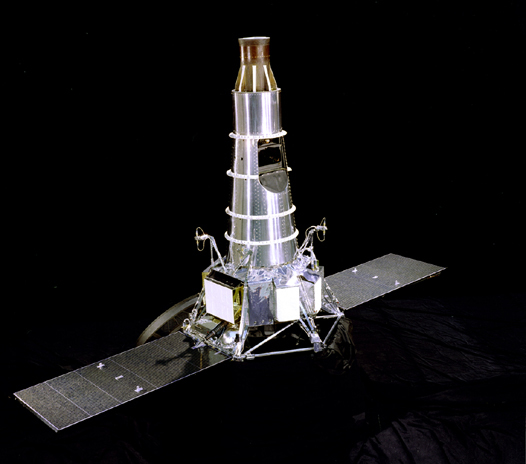
The process of approaching the moon (video accelerated)
The shooting was done right up to the collision, but due to the high speed of the station relative to the moon, the last image was taken from a height of about 488 meters and was not transmitted to the end:

With exactly the same purpose, Ranger-8 and Ranger-9 were launched (February 17 and March 21, 1965, respectively).
Better pictures of the far side of the moon were obtained by Zond-3 station launched on July 18, 1965. Initially, this station was preparing, together with Zond-2, to fly to Mars, but because of problems, the starting window was missed and Zond-3 went to fly around the moon. To test the communication system, photographs obtained by the station were transmitted to Earth several times.
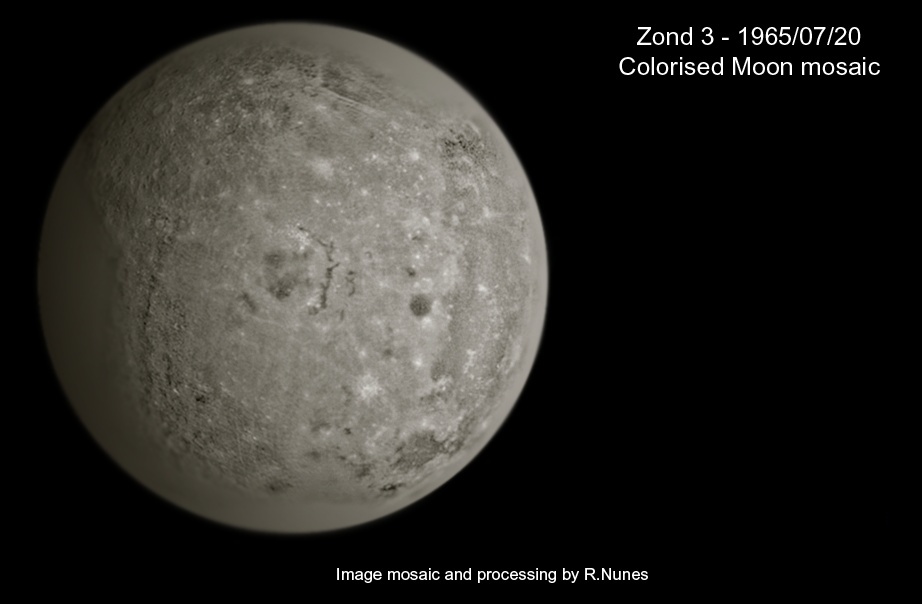
Photo taken by Probe-3
Soft landing and soil delivery
The task of a soft landing on the moon was much more complex and after a series of failures, it was carried out only on February 3, 1966 by Luna-9 station launched on January 31. The device had a rather complicated structure:
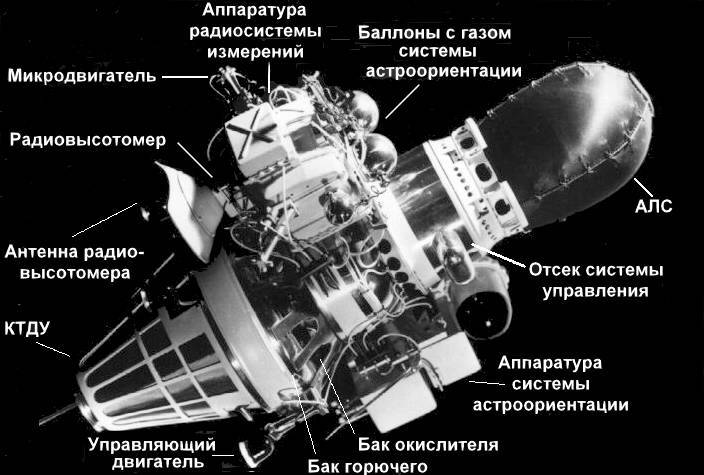
Due to the fact that nothing was known about the surface of the moon, the landing process was rather intricate:
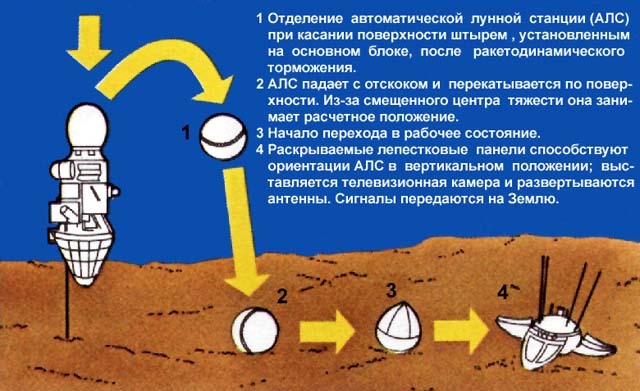
The complexity of the landing system did not pass without a trace: from the landing station of 1.5 tons, only 100 kg of ALS remained with a weight that looked like this on the surface:

Since the illumination on the moon changes extremely slowly (the moon rotates only 1 ° in 2 hours relative to the sun) it was decided to use an optical-mechanical shooting system which was much more reliable, lighter and consumed less energy. Its slow speed of work even turned out to be a positive factor - there was a rather slow communication channel for data transmission, so the ALS could do with non-directional antennas.
The first photograph of the lunar surface was a circular panorama with a resolution of 500 by 6000 pixels. It took 100 minutes to shoot a single photograph. The television camera had a vertical angle of 29 °, in addition to which the design of the device provided for its inclination by 16 ° relative to the vertical of the terrain - so that it could capture both the far panorama and the surrounding surface microrelief:
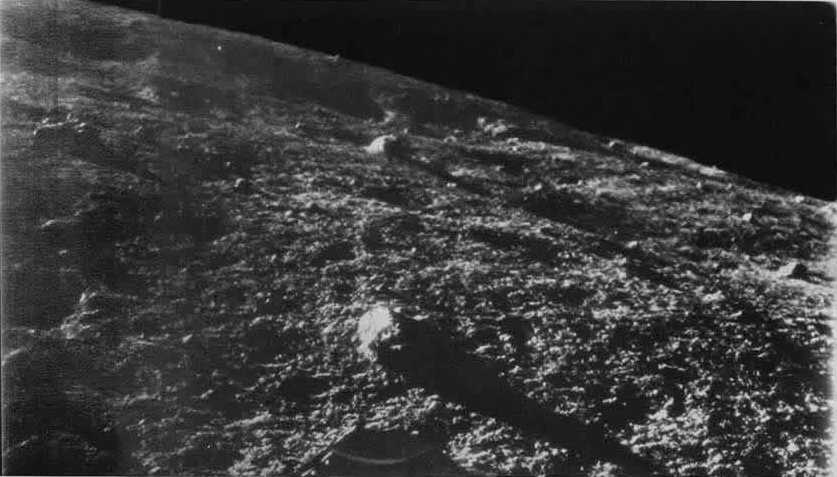
By clicking the full panorama of the moon. Additional photos of the station's device can be seen here , and the camera leading the shooting looked like this:

At the moment, NASA enthusiasts are going to look for a flight block and remnants of an inflatable shock absorber station using LRO photos (the device itself is too small to be seen - it should look like 2 * 2 pixels in LRO pictures).
The Americans managed to land the descent vehicle Surveyor-1 by June 2 (4 months after our station). Many sensors were installed on it:
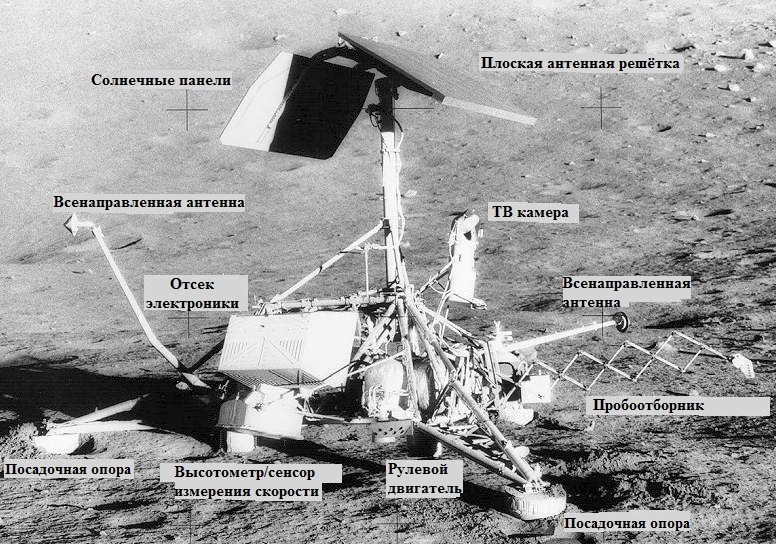
The device itself landed from the migratory trajectory, so the instruments for this purpose were installed on it: the main engine (dropped at a height of 10 km), steering engines and an altimeter / speed sensor. Planting supports were made of aluminum honeycombs to soften the blow when stopping. Among the target equipment of the apparatus were a television camera, a sensor for analyzing the light reflected from the surface (for determining the chemical composition of the soil) and sensors for determining the surface temperature. Starting with the third apparatus, a sampler was also installed which was used to make trenches to determine the properties of the soil. Of the 7 Surveyors sent to the Moon until February 1968, two crashed in the process of braking near the Moon, and the rest 5 sat down and completed their tasks of exploring the Moon.
On March 31, 1966, the Luna-10 station was launched, which, by April 3, for the first time in history entered the orbit of our satellite. She had a gamma spectrometer, magnetometer, meteorite detector, a device for studying the solar wind and infrared radiation of the moon. The studies of gravitational anomalies of the Moon ( mascons ) were also conducted. The total duration of the mission was about 3 months. For the same purpose, Luna-11 and Luna-12 stations were launched (August 24 and October 22, respectively).
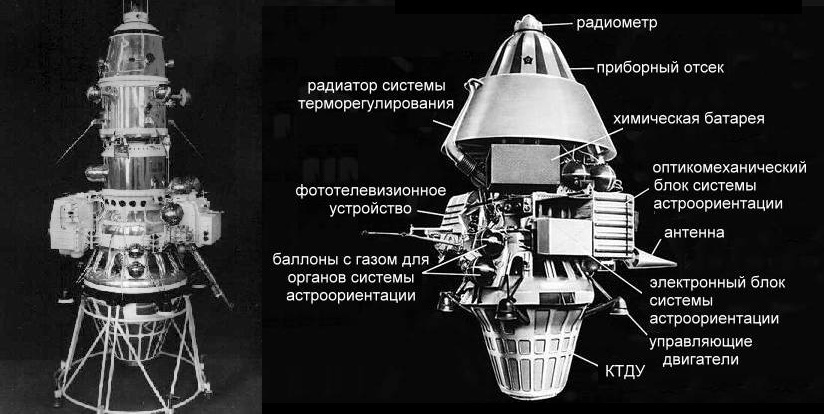
General view of the station with the migratory stage and its design. This flight level was also used in stations from Luna-4 to Luna-9 inclusive.
Since August 10, 1966, five Lunar Orbiter vehicles were sent to the Moon. Like the Soviet stations, they used film for filming. Since they were already launched as part of the preparation of the Apollo program , the cartography of the Moon first of all included pictures of future landing sites of the Lunar modules . Their work time was less than two weeks, the pictures had a resolution of up to 20 meters and covered 99% of the entire lunar surface, and for 36 potential landing sites, pictures were taken with a resolution of 2 meters.

The device itself was quite large: with a total construction weight of only 385.6 kg, the size of the solar panels was 3.72 meters, and the directional antenna was 1.32 meters in diameter. The photographic equipment had two lenses for simultaneous wide-angle shots and high-resolution shots. This system was developed by Kodak based on optical reconnaissance systems for U-2 and SR-71 aircraft.
In addition, they had micrometeorite detectors and a radio beacon to measure gravitational conditions near the moon (with the help of which mascons were also observed). They threatened the safety of astronauts, since the landing without their calculations could lead to a deviation of 2 km instead of the standard 200 m. A painstaking study of the orbits of the devices made it possible to measure the influence of mascons and improve the accuracy of landing - Apollo 12 was able to sit down with a deviation of only 163 meters from your goal.
On July 19, 1967, in parallel with the “Surveyor” and “Lunar Orbiter” programs, the Explorer-35 apparatus was launched, which worked in the lunar orbit for 6 years - until June 24, 1973. The device was designed to study the magnetic field, the composition of the surface layers of the moon (by the reflected electromagnetic signal), register ionizing particles, measure the characteristics of micrometeorites (in speed, direction and rotational moment) as well as study the solar wind.
The next Soviet apparatus directed toward the Moon was Zond-5 launched on September 15, 1968. The vehicle was the Soyuz 7K-L1 spacecraft, launched by the Proton launch vehicle and intended to fly around the moon. In addition to testing the ship itself, he also had a scientific goal: the first living creatures that flew around the moon flew on it 3 months before Apollo 8 - these were two turtles, Drosophila, and several plant species. After the flight of the moon, the descent capsule fell down in the waters of the Indian Ocean:
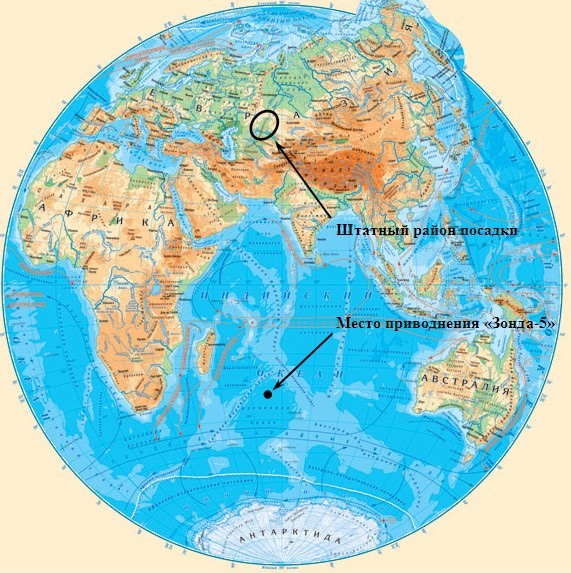
Apart from the problems with overloads during landing, the flight went normally, so the next probe Zond-6 (launched on November 10, 1968) was no longer landing at sea but in the state landing area in the USSR. Unfortunately, he crashed at the parachute descent stage: they were shot at an altitude of about 5 km instead of the calculated moment just before touching the earth and all biological objects on board (which were sent around the moon and in this flight) died. However, the film with black and white and color photographs of the moon has been preserved.

Two more successful launches of this ship were made: Zond-7 and Zond 8 (August 8, 1969 and October 20, 1970, respectively) with successful returns of descent vehicles.
July 13, 1969 (three days before the start of Apollo 11 ), the station Luna-15 was launched, which was supposed to deliver samples of lunar soil to Earth before the Americans had to do it. However, in the process of braking, the moon lost contact with her. As a result, the first automatic station to deliver samples of lunar soil was the Luna-16 launched on September 12, 1970:
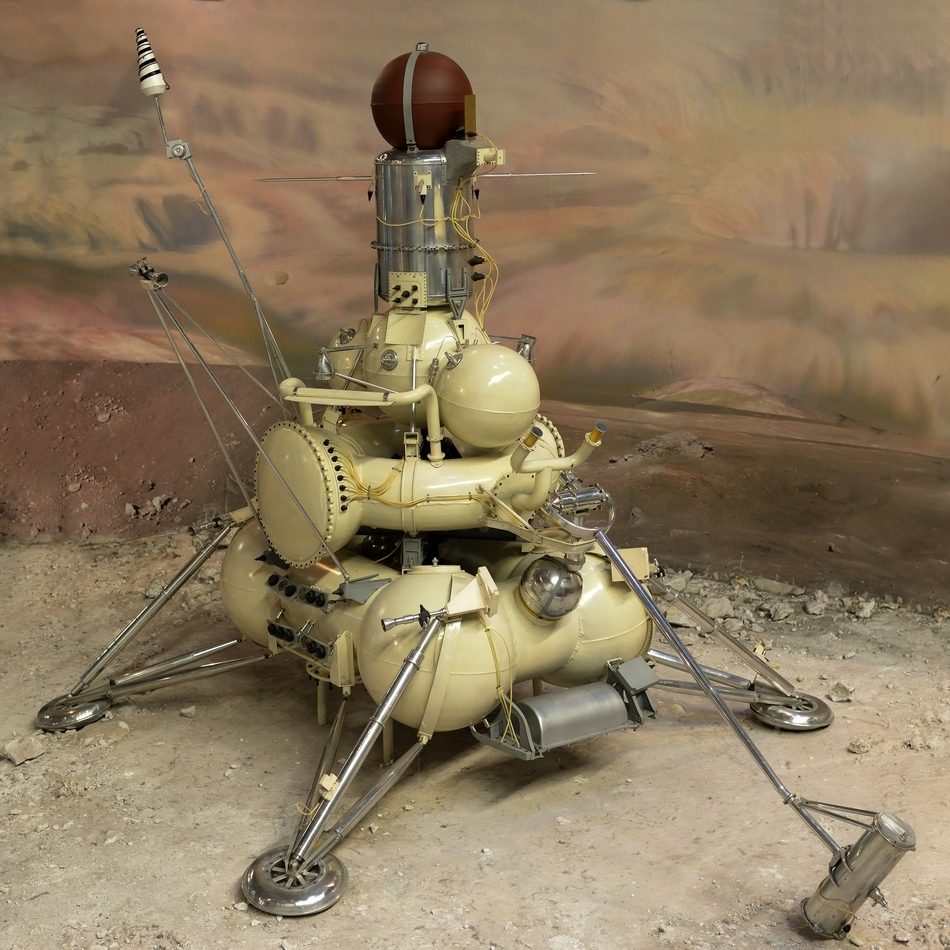
On September 20, a landing gear weighing 1880 kilograms reached the surface of the moon. The sample was obtained with the help of a drill, which reached 35 cm depth within 7 minutes and collected 101 grams of lunar soil. Then, the return vehicle weighing 512 kg was launched from the Moon, and already on September 24, the samples on a 35-kilogram descent vehicle landed in Kazakhstan.
Also, Luna-20 and Luna 24 stations (launched on February 14, 1972 and August 9, 1976, delivered 30 and 170 grams of soil, respectively) were sent for the purpose of delivering lunar soil. Luna-24 managed to get soil samples from a depth of 1.6 m. A small portion of lunar soil was transferred to NASA in December 1976. The Luna-24 station was the last for the next 37 years, the device that carried out a soft landing on the Moon - up to the landing of the Chinese Jade Hare .
Moon rovers and the finale of the first stage of research
Launched on November 10, 1970, Luna-17 station delivered the world's first planet-cruiser: Lunokhod-1, which worked on the surface for 301 days. Two telecameras, 4 telephotometers, an X-ray spectrometer and an X-ray telescope, an odometer-penetrometer, a radiation detector and a laser reflector were installed on it.
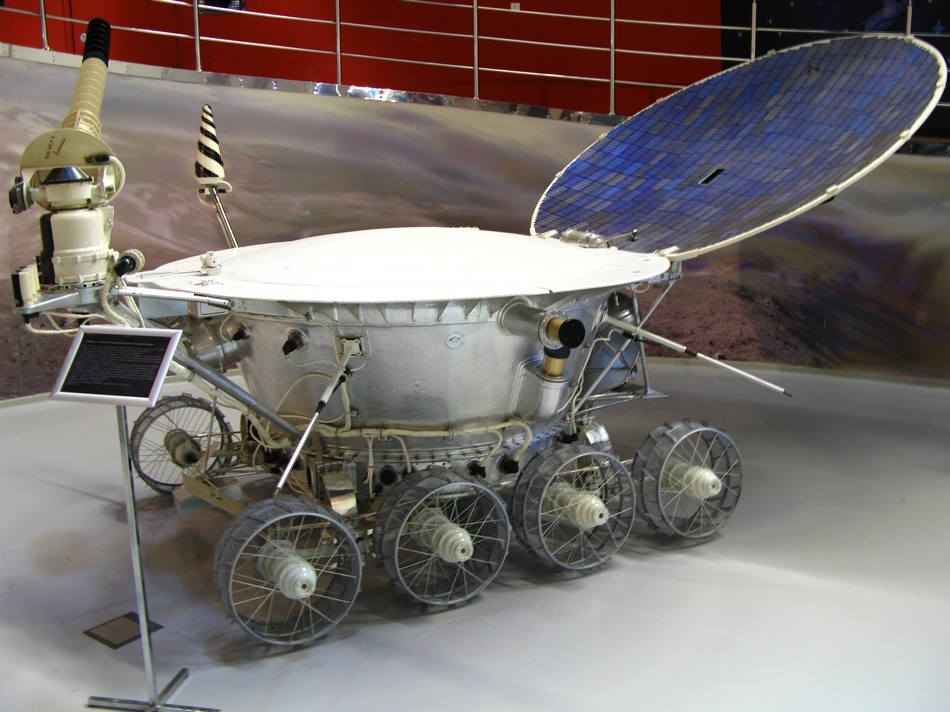
During his work, he traveled more than 10 km, transferred about 25 thousand photographs to the earth, 537 measurements of the physical and mechanical properties of the lunar soil were made, and 25 times chemical. The remote control of the Lunokhod January 8, 1973 was launched Lunokhod-2 which had the same design. Despite the breakdown of the navigation system, he managed to drive more than 42 km, which was a record for planet rovers until 2015, when this record was broken by the Opportunity rover. The flight of Lunokhod-3 scheduled for 1977 - unfortunately was canceled. Photos of the Lunokhod-3 in the Museum of Scientific-Production Association named after S. A. Lavochkin

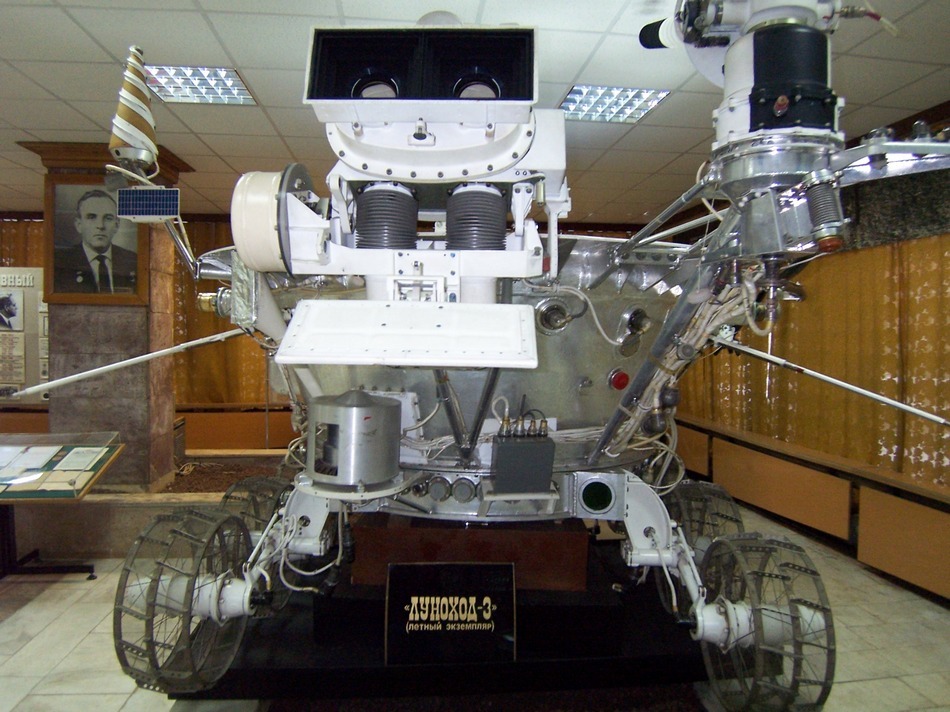

On October 3, 1971, the automatic interplanetary station Luna-19 was launched into the Moon's orbit using the Proton-K rocket, which lasted 388 days. Its weight was 5.6 tons and it was built on the basis of the design of the previous Luna-17 station:

The scientific equipment included a dosimeter, a radiometric laboratory, a magnetometer mounted on a 2 meter rod, an apparatus for determining the density of meteoritic matter and a camera for shooting the surface of the Moon . One of the main tasks of the apparatus was the study maskon. Due to the failure of the control system and the entry into the non-calculated orbit, it was decided to abandon the task of mapping the moon. During the flight, additional data were obtained on the magnetic field of the Moon and it was established that the density of meteoritic particles near the Moon does not differ from their concentration in the range of 0.8-1.2 AU. from the sun.
On May 29, 1974, the Luna-22 station was launched with the same scientific program, the station worked 521 days. These stations made it possible to refine the gravitational fields of the moon, and simplify the landing of Luna-20 and Luna-24 stations for soil selection.
Quite remarkable was the satellite "Explorer-49"which was launched on June 10, 1973. Its huge antenna consisted of 4 elements 230 meters long. But although it was launched into the Moon’s orbit, it was not intended for its research - it studied galactic radio emission at frequencies of 25 kHz and 13.1 MHz (Explorer 38 was launched earlier for the same purposes).
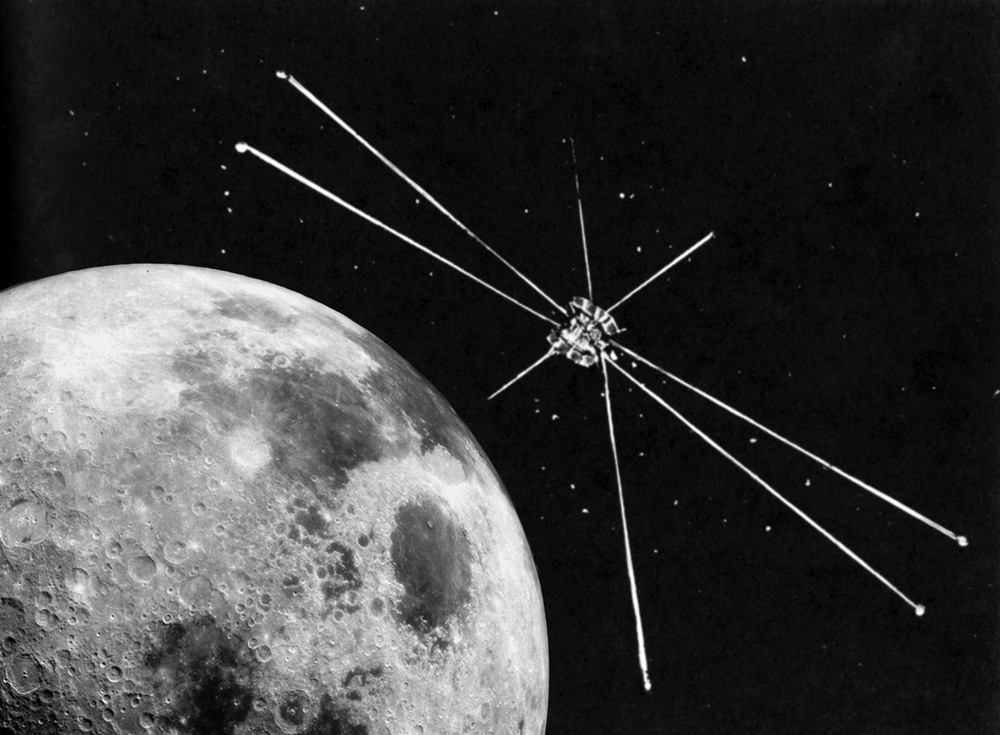
This ended the first stage of the Moon research in which in fact there were only two participants - the USA and the USSR. To be continued...
All Articles